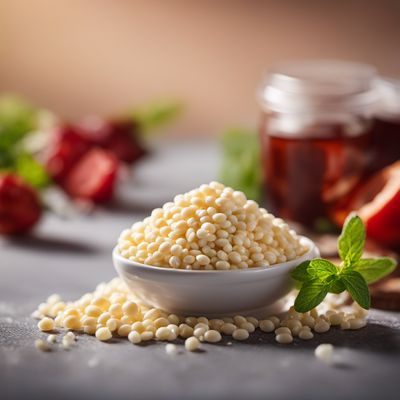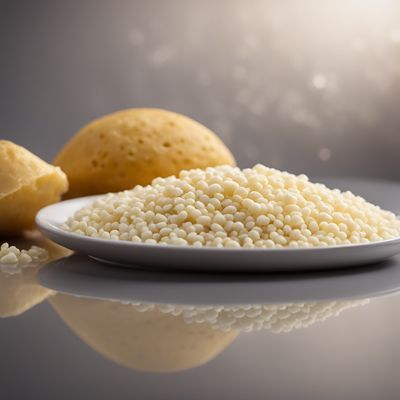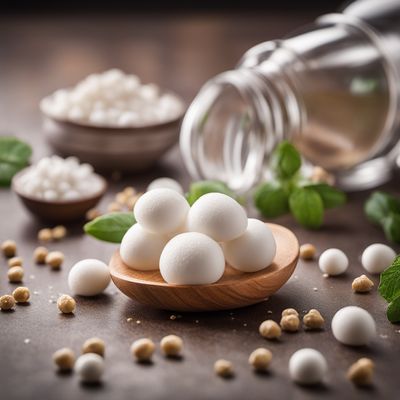
Ingredient
Isomalt
The Sweet Secret: Isomalt
Isomalt is a sugar alcohol derived from beet sugar. It is a white, crystalline substance that resembles regular sugar but has a slightly sweeter taste. With a low glycemic index and fewer calories than sugar, isomalt is a popular choice for individuals looking to reduce their sugar intake. It has a smooth texture and can be melted and molded into various shapes, making it ideal for creating intricate sugar decorations and edible sculptures. Isomalt is also known for its resistance to humidity, making it a preferred ingredient for candies and lollipops that need to maintain their shape and clarity.
Origins and history
Isomalt was first developed in the 1960s as a sugar substitute. It gained popularity in the confectionery industry due to its unique properties, including its resistance to humidity and ability to withstand high temperatures without caramelizing. Isomalt is commonly used in sugar art and confectionery, allowing pastry chefs and sugar artists to create stunning edible decorations and showpieces. It is widely used in Europe and has gained recognition worldwide for its versatility and benefits as a sugar substitute.
Nutritional information
Isomalt is low in calories and has a low glycemic index, making it a suitable option for individuals watching their sugar intake. It contains approximately 2 calories per gram, compared to 4 calories per gram in regular sugar.
Allergens
Isomalt is generally considered safe for consumption, but excessive intake may cause gastrointestinal discomfort, such as bloating or diarrhea, in some individuals. It is recommended to consume isomalt in moderation and consult a healthcare professional if any adverse effects occur.
How to select
When selecting isomalt, look for a high-quality product that is pure and free from impurities. It should be in crystalline form and have a clean, white color. Avoid products that appear yellowish or have a strong odor, as these may indicate impurities or degradation. Additionally, check the packaging for any signs of damage or tampering.
Storage recommendations
To maintain the freshness and quality of isomalt, store it in an airtight container in a cool, dry place away from moisture and direct sunlight. Isomalt has a long shelf life and can be stored for extended periods without significant degradation.
How to produce
Isomalt is not a naturally occurring ingredient and is typically produced through a chemical process. It is not suitable for amateur production as it requires specialized equipment and knowledge. It is best to purchase isomalt from reputable suppliers or specialty stores.
Preparation tips
When working with isomalt, it is important to handle it with caution as it can reach high temperatures when melted. Use heat-resistant gloves and protective eyewear to prevent burns. To melt isomalt, place it in a heatproof container and heat it in the microwave or on a stovetop until it reaches a clear, liquid state. Be careful not to overheat it, as it can quickly turn amber and become caramelized. Once melted, isomalt can be poured into molds or used to create intricate sugar decorations. It can also be colored using food coloring or flavored with extracts or oils. When using isomalt in recipes, follow the instructions carefully and consider its unique properties, such as its resistance to humidity and ability to harden quickly.
Culinary uses
Isomalt is commonly used in sugar art and confectionery, including the creation of sugar flowers, sculptures, and showpieces. It is also used to make clear candies, lollipops, and edible decorations for cakes and desserts. Additionally, isomalt can be used as a sugar substitute in various recipes, such as sugar-free desserts, jams, and beverages.
Availability
Isomalt is widely available in specialty baking stores, confectionery supply shops, and online retailers. It is commonly used in Europe and North America, but its availability may vary in other regions.
More ingredients from this category

Mannitol
The Sweet Alcoholic Sugar

Sorbitol
Sweetener with a Twist

Other polyols
The Sweet Side of Sugar Substitutes: Exploring Other Polyols

Lactitol
"The Sweet Secret: Exploring the Versatility of Lactitol"

Xylitol
The Sweet Tooth's Ally

Erythritol
Natural Sugar Substitute

Maltitol
The Sweet Secret: Maltitol